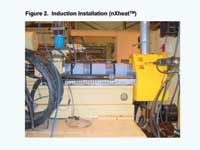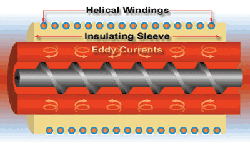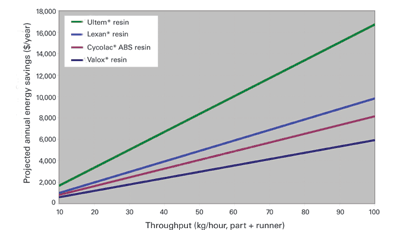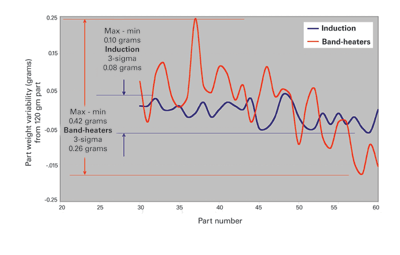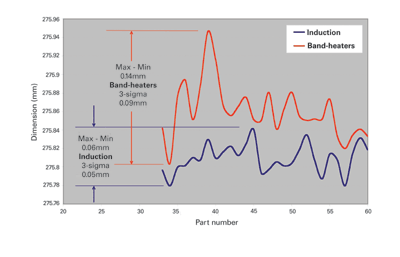It's practically invulnerable and cuts energy consumption, barrel heating time, and part-weight variability in half when compared to conventional band heaters. True? We asked a representative of the technology's supplier.
July 1, 2008
It's practically invulnerable and cuts energy consumption, barrel heating time, and part-weight variability in half when compared to conventional band heaters. True? We asked a representative of the technology's supplier.
Unlike conventional heater bands, which only heat the surface of an injection unit's barrel, the heat produced by the induction barrel heating system now trademarked nXheat by its developer, Xaloy Inc. (New Castle, PA), penetrates deep into the barrel, heating the barrel inside-out. It uses a layer of thermal insulation inserted in-between a contiguous, helically wound induction heating coil and the barrel.
Heat loss is minimal. In fact, while it's in operation, you can safely touch an induction-heated barrel with your bare hand.
And when it comes to keeping things “green,” induction barrel heating consumes up to 75% less power than heater bands. Xaloy reportedly found that induction heating can provide this kind of energy savings after testing its system against several different types of band heaters at different temperatures for days on end.
|
|
Xaloy's nXheat induction heating system creates an oscillating electromagnetic field that directly heats the steel of the injection barrel.
Late last year Xaloy introduced a hybrid version of its nXheat induction barrel heating system. You can read our initial report on the technology online at immnet.com/product_news/2007/September/2204.
Also, in a presentation he coauthored with technical representatives of Sabic Innovative Plastics (Pittsfield, MA) at Executive Conference Management's Molding 2008 conference and exhibition (Feb. 18-20; San Francisco, CA-cosponsored by IMM), Bruce F. Taylor, Xaloy's nXheat business manager, jointly presented details on how induction barrel heating not only can dramatically reduce energy consumption when compared to conventional heater bands, but also can improve part-to-part consistency by reducing part weight variability and improving part dimensional stability. Illustrations from the presentation are included in this report.
But how about maintenance vs. heater bands? That's just one of the questions we asked in a recent interview. Here's what Xaloy's Taylor had to say:
IMM: How did you arrive at the impressive performance figures reported for the technology?
Taylor: One of our first beta sites, a molder in the Midwest, was very helpful in verifying the results we observed in our own tests. They were doing a considerable number of mold changes on a 1000-tonner equipped with our system to see if it could improve the uniformity of different parts over time.
They recorded a sizable scrap reduction-it was so big they decided to do long-term verification testing, involving part weight and cavity pressure.
Conventional barrel heaters are rather sluggish and inefficient. Induction barrel heating uses a layer of thermal insulation in-between the induction coils and the barrel-our testing has shown this system is not only much more efficient, but also much more responsive.
IMM: Why?
|
|
|
Taylor: Heater bands have to conduct heat across the contact resistance between the bands and the barrel. Then the heat has to pass through the barrel wall to heat the molding material.
Induction heating creates an oscillating electromagnetic field that directly heats the barrel steel itself, so the barrel essentially becomes the heating element. The heating depth is also a function of the frequency of the oscillating magnetic field. Our system uses a relatively low frequency that allows the energy to penetrate deep into the barrel.
The insulation in-between the induction coil and the barrel prevents the heat from escaping. Induction also has virtually insignificant thermal inertia, whereas a band heater's mass has to be heated and cooled along with the barrel.
IMM: Better heating means better parts faster?
Taylor: Naturally, and more consistent part weight and less dimensional variability are the result. In the tests conducted at Sabic Innovative Plastics we ran both heater bands and our nXheat system with the same mold, materials, and process settings. There was a 50% reduction in the part weight variability, on average, and a 25% reduction in dimensional variability [see Figures 2 and 3]. We concluded that induction barrel heating is likely to produce more consistent parts, particularly as production conditions get more demanding.
IMM: Any idea of its effectiveness on hydraulic and all-electric machines?
Taylor: Our tests at Sabic Innovative Plastics showed a statistically insignificant change in the amount of electrical energy consumed by the injection unit's hydraulic pump motor. So, it appears the barrel heating method doesn't significantly affect the efficiency of materials conveying. However, we do believe induction inherently produces a more consistent melt quality. We're not sure why this is, but it may be due to the ability to pre-heat the resin faster, in a shorter rear portion of the barrel, leaving more of the remainder of the barrel and screw to accomplish thorough melting and mixing.
That said, we found that the ratio of the total energy consumed by the injection unit-including the unit's hydraulic pump motor's energy consumption plus the band heater's energy consumption-could be reduced on average by about 8-12%, depending on the type of resin run.
On an all-electric the ratio of the injection unit's total energy consumption to the band heater's energy consumption may be about half that of a hydraulic, so we believe induction barrel heating should reduce total energy consumption on all-electric machines anywhere from 15-25%. We're planning on more testing to confirm this.
IMM: How does the length of a run or the size of the press affect performance?
Taylor: Naturally, improved response will provide more benefits on shorter runs, involving quick changeovers. Also, because larger machines lose more heat, nXheat energy savings increase with machine size. So, to this point we've focused our efforts on bigger machines. But we've just recently installed nXheat on a number of small machines and are looking forward to seeing the benefits that may be unique to small, high-speed machines.
Still, in order to be commercially successful, near-term, we have to focus our application development and engineering efforts where the energy savings will be sufficient to justify the product.
IMM: How about its affect on the molding process itself?
Taylor: Our customers say nXheat induction heating allows them to get their machines up to temperature faster at startup, so if there's a pressing production schedule, molders can make good parts faster. Generally, they also say nXheat provides a wider operating window, which we think means it's easier to hold a consistent melt temperature. In practice, some customers are then able to reduce backpressure and melt temperature, to reduce overpacking, degradation of shear-sensitive materials, and material use.
It's also much easier and faster to change a barrel temperature from the initial target to a new one. There's no thermal inertia, so the temperature drops more quickly, providing faster feedback to the changes made, so there's also less likelihood of overshooting.
IMM: Any concerns about possible misuse of the technology?
Taylor: Some people may want to use this technology all over the place-such as in molds, for instance, where it may be valuable but will need to be applied in very different ways. Induction heating isn't the answer to everything. It's more difficult to use in applications lacking the geometry of an injection barrel. It's not that easy to translate it to other applications.
It may also be worthwhile for users to retune their molding machine temperature controllers. The ideal time to add heat is when cold material comes in-when the material enters barrel. That's when heat is needed. The rear zone does the majority of barrel heating. Shear heating from the screw happens further down.
The way most machines are set up, on/off heater bands are slow to respond. Turning them on and off can vary the time it takes to heat the barrel. Induction heating is so responsive that it can quickly produce measurable changes on every cycle. Ideally, the barrel heating control interval should be equal to the machine cycle.
IMM: Any other issues of concern?
Taylor: Most machines have J-type thermocouples. Stainless-steel bayonet thermocouples are advised for our nXheat system, although many machines have not required them. Standoff adapters are generally required because of the clearance involved, due to our insulation layer, which is about 1 inch thick. Also, deeper thermocouple depths may be beneficial to take maximum advantage of the faster heating response, but they're not needed to obtain good results.
Things are going to change. Band heaters are not inherently uniform around the circumference of a barrel. There are hinges, latches, electrical terminals-so they don't cover the entire circumference of a barrel. That's an even bigger issue on smaller barrels.
We actually tested heater bands with thermocouples down inside injection barrel walls. There was quite a temperature variation-quite a difference around the circumference. With nXheat induction heating there was zero difference because it's perfectly symmetrical.
So, in addition to more uniform production of quality parts and significant reductions in power consumption, users should also gain longer screw and barrel life.
IMM: What's its impact on maintenance?
Taylor: Say you've got a 15-band, five-zone system-if there's a band failure, the zone typically continues to operate, but at less-than-optimal conditions.
Now with nXheat you've got a single, contiguous coil from beginning to end. If there's ever a failure, the entire zone goes out and the machine must be stopped and fixed. You won't go days, weeks, or months with your machine not running properly.
IMM: So, better service life is another benefit?
Taylor: There are only two components-the coil itself over the insulation layer. The cable is rated up to 180°C, about 356°F, outside of the insulation, and as we said before it normally runs so cool you can put your hand on it. The only issue is if someone physically damages a cable, but they're Teflon-coated to reduce the chance of that happening.
And the power modules that deliver the high-frequency output to the coils are extremely robust. They were initially developed for mission-critical applications in metals and pulp-and-paper processing.
IMM: How would you summarize the benefits your system provides?
Taylor: Our nXheat system uses up to 75% less power. We've tested all kinds of band heaters, new and old ones, and after days of operation at different temperatures with different materials, analyzing the ratio between the amount of heat delivered to the process provided and the total power consumption, we found that our system can reduce the amount of power required to heat barrels by up to 75%.
Contact information: |
About the Author(s)
You May Also Like
